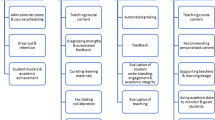Abstract
Despite the value of the comparative perspective for the study of higher education is widely recognised, there is little consensus about the specific methodological approaches. Quantitative tools outlined their relevance for addressing comparative analyses since they are supposed to reducing the complexity, finding out and graduating similarities and differentiations, and improving the generalization of the results. Nevertheless, the limited availability of comparative data hampers statistical comparative analyses, and data and statistics might be seen just as complementary analytical tools. This paper has a twofold aim. Firstly, it addresses key methodological problems for accurate international comparisons in higher education studies. Secondly, the article discusses the difficulties encountered in using measurements in comparative studies, and issues to be addressed in order to improve the robustness of the method and the possibility of using quantitative tools.
Similar content being viewed by others
References
Aldricht, H. (2009). Lost in space, out of time: Why and how we should study organizations comparatively. In B. King, T. Felin, & D. Whetten (Eds.), Studying differences between organizations: Comparative approaches to organizational research. Research in the Sociology of Organizations, 26, 21–44.
Allardt, E. (1990). Challenges for comparative social research. Acta Sociologica, 33, 183–193.
Azarian, R. (2011). Potential and limitations of comparative method in social science. International Journal of Humanities and Social Science, 1(4), 113–125.
Bagshaw, D., Lepp, M., & Zorn, C. (2007). International research collaborations: Building teams and managing conflicts. Conflict Resolution Quarterly, 24(4), 433–446.
Barré, R. (2010). Towards socially robust S&T indicators: Indicators as debatable devices, enabling collective learning. Research Evaluation, 19(3), 227–231.
Barré, R., & Régibeau, P. (2009). Report of the expert group “ERA indicators and ERA monitoring”. Luxembourg: EC.
Birnbaum, R. (1983). Maintaining diversity in higher education. San Francisco: Jossey-Bass.
Bonaccorsi, A., Brandt, T., De Filippo, D., Lepori, B., Molinari, B., Niederl, A., et al. (2010). Feasibility study for creating a European University Data Collection. Final Study Report. Brussels: European Commission, DG Research.
Borden, V. M. H., Calderon, A., Fourie, N., Lepori, B., & Bonaccorsi, A. (2013). Challenges in developing data collection systems in a rapidly evolving higher education environment. New Directions for Institutional Research, 157, 39–58.
Cohen, L., & Manion, L. (2000). Research methods in education. London: Routledge.
Collier, D. (1993). The comparative method. In A. W. Finifter (Ed.), Political science: The state of the discipline II (pp. 105–119). Washinghton DC: American Political Science Association.
Fairbrother, G. (2007). Quantitative and qualitative approaches to comparative education. In M. Bray, et al. (Eds.), Comparative education research: Approaches and methods (pp. 39–62). Dordrecht: Springer.
Huisman, J., Meek, L., & Wood, F. (2007). Institutional diversity in higher education: A cross national and longitudinal analysis. Higher Education Quarterly, 61(4), 563–577.
Kogan, M. (1996). Comparing higher education systems. Higher Education, 32, 395–402.
Kogan, M., & Bleiklie, I. (2006). Comparison and theories. In M. Kogan, et al. (Eds.), Transforming Higher Education: A comparative Study (pp. 11–33). London and Philadelphia: Jessica Kingsley Publishers.
Kuechler, M. (1987). The utility of surveys for cross-national research. Social Science Research, 16(3), 229–244.
Lange, P., & Meadwell, H. (1985). Typologies of democratic systems: From political inputs to political economy. In H. J. Wiarda (Ed.), New directions in comparative politics. Westview: Boulder.
Lazarsfeld, F., & Barton, A. (1951). Qualitative measurement in the social sciences: Classifications, typologies and indices. In D. Lerner & H. D. Lasswell (Eds.), The policy sciences: Recent developments in scope and method (pp. 155–192). Stantford: Stantford University Press.
Lepori, B., Barré, R., & Filliatreau, G. (2008). New perspectives and challenges for the design and production of S&T indicators. Research Evaluation, 17, 33–44.
Lepori, B., & Bonaccorsi, A. (2013). The socio-political construction of a European census of higher education institutions. Design, methodological and comparability issues. Minerva. doi:10.1007/s11024-013-9235-9.
Lijphart, A. (1971). Comparative politics and the comparative method. American Political Science Review, 65(Sept), 682–693.
Manardi, A. (1990). Classification, typology, taxonomy. Quality & Quantity, XXIV(2), 129–157.
McMichael, P. (1990). Incorporating comparison within a world-historical perspective: An alternative comparative method. American Sociological Review, 55(3), 385–397.
Neave, G. (1996). Higher education policy as an exercise in contemporary history. Higher Education, 32, 403–415.
Page, E. C. (1995). Comparative public administration in Britain. Public Administration, 73(1), 123–141.
Ragin, C., & Zaret, D. (1983). Theory and method in comparative research: Two strategies. Social Forces, 61, 731–754.
Reale, E., Inzelt, A., Lepori, B., & van den Besselaar, P. (2012). The social construction of indicators for evaluation: Internationalization of funding agencies. Research Evaluation, 21, 245–256.
Sartori, G. (1970). Concept misformation in comparative politics. American Political Science Review, 64(4), 1033–1053.
Smelser, N. (1976). Comparative methods in the social sciences. Englewood Cliffs, NJ: Prentice-Hall.
Teichler, U. (1996). Comparative higher education: Potential and limits. Higher Education, 32, 431–465.
Valimaa, J. (2009). On comparative research in higher education. In A. Amaral, et al. (Eds.), From governance to identity (pp. 141–155). Dordrecht: Springer.
Van der Ploeg, F., & Veugelers, R. (2008). Towards evidence-based reform of European Universities. CESifo Economic Studies, 54(2), 99–120.
van Mierlo, H., Vermunt, J. K., & Rutte, C. G. (2009). Composing group-level constructs from individual-level survey data. Organizational Research Methods, 12(2), 368–392.
Van Vught, F. A. (Ed.). (2009). Mapping the higher education landscape: Towards a European classification of higher education. Dordrecht: Springer.
Van Vught, F. A., Bartelse, J., Huisman, J., & van der Wende, M. (2005). Institutional profiles, towards a typology of higher education institutions in Europe. Enschede: CHEPS.
Van Vught, F. A., Kaiser, F., File, J. M., Gaethgens, C., Peter, R., & Westerheijden, D. F. (2010). U-Map-The European classification of higher education institutions. Enschede: CHEPS.
Van Vught, F. A., & Ziegele, F. (Eds.). (2012). Multidimensional ranking: The design and development of U-multirank. New York: Springer, Science+Business Media.
Verba, S. (1967). Some dilemmas in comparative research. World Politics, 20, 111–127.
Author information
Authors and Affiliations
Corresponding author
Rights and permissions
About this article
Cite this article
Reale, E. Challenges in higher education research: the use of quantitative tools in comparative analyses. High Educ 67, 409–422 (2014). https://doi.org/10.1007/s10734-013-9680-2
Published:
Issue Date:
DOI: https://doi.org/10.1007/s10734-013-9680-2




